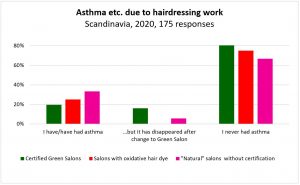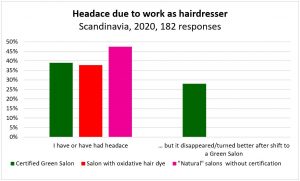Green Salon has conducted three questionnaire surveys of the working environment in the certified Green Salons and Clinics in 2007, 2011 and 2020. We have asked about conditions such as headaches, allergies and difficulty breathing. Here the survey from 2020 is reviewed.
Allergy due to hairdressing
25 % of the Green Salon hairdresser states that she has or has had allergies, but of these hairdressers who have or have had allergies, 80% state that their work related allergies disappeared or became smaller after becoming a Green Salon- hairdresser.

Breathing difficulties due to hairdressing
A third of all hairdressers experience respiratory irritation due to work, and in the Green Salon survey, 20% of the hairdressers in the Green Salons stated that they have or have had respiratory irritation. Among the Green Salon hairdressers who have or have had breathing difficulties, 80% say that it turned better or disappeared after they became a Green Salon hairdresser.

Headache due to hairdressing
Work-related headaches are very common in the hairdressing profession, and three out of four hairdressers state that they suffer from headaches. Among the Green Salon hairdressers who have or have
had headaches, two out of three state that their headaches were eliminated or reduced by the change to Green Salon. The frequency of headaches is also reduced for hairdressers in Green Salons.


A little more detail from the survey
Allergy
25% of the hairdressers in the certified Green Salons state that they have or have had allergies as a result of the hairdressing work, correspondingly 75% state that they have never had it. Of the Green Salon
hairdressers who have or have had allergies, 80% state that their allergies disappeared or became less after they became Green Salon hairdressers. It seems that half of the hairdressers in salons who call themselves green or organic, but who are not certified, get allergies due to work. Several of these “organic” hairdressers without certification state that their color systems are based on extremely allergenic substances such as PPD or PTD.
Breathing difficulties
About a third of all hairdressers experience respiratory irritation due to work (source: Working environment is your everyday life, DFKF, 2005). In the Green Salon survey, 20% of the hairdressers in the Green Salons stated that they have or have had respiratory irritation. Among the Green Salon hairdressers who have or have had difficulty breathing, 80% say that it has turned better after they became a Green Salon hairdresser. Of the “organic” hairdresser without certification, 33% have respiratory irritation due to work.
Headache
72% of hairdressers in Denmark have headaches due to work, mostly due to lack of breaks and poor indoor climate (source: Working environment is your everyday life, DFKF, 2005).
In the Green Salon’s work environment survey, 39-45% of the hairdressers in the various groups state that they have or have had headaches due to work. Among the Green Salon hairdressers who have or have had headaches, two thirds state that their headaches were eliminated or reduced by a switch to Green Salon. The same pattern is seen for the frequency of headaches.
About the Green Salon’s work environment survey 220
The survey was conducted September to November 2020 and received 204 responses from Denmark, Norway, Iceland and Sweden in particular. 195 of the respondents are or have been hairdressers. There
were 5 responses from beauticians, which are so few that we have chosen not to include their answers in the graphs above. 123 responses came from hairdressers who work in a certified Green Salon, and 52 responses came from hairdressers in salons who use oxidative hair dyes (ie hair dyes with PPD or PTD). 17 responses came from hairdressers who stated that they work in a salon that calls itself green or environmentally friendly, but which is not certified Green Salon. Some of the hairdressers in these salons, which we call “organic salon without certification” state that they use oxidative dyes with PPD or PTD, ie. products that will never be allowed in the Green Salon due to the risk of severe allergies. It should be noted that the number of responses, just over 200, is too small to justify very sharp conclusions. The information is self-reported, ie. the accuracy is not verified. The results of the study should therefore only be considered as a guidance. However, it should be noted that the results of the survey are very much like the results from the Green Salon’s work environment survey in 2011 and 2017.
